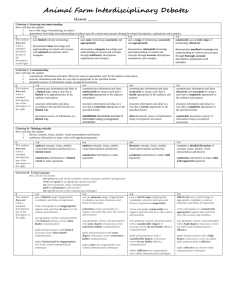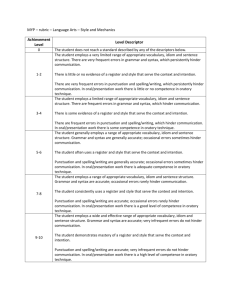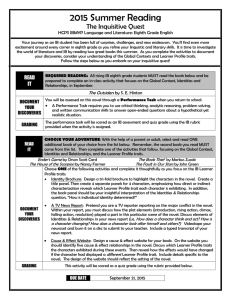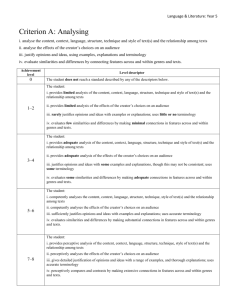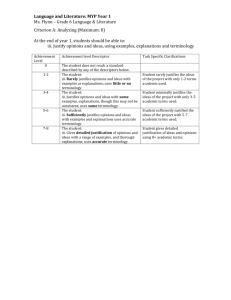Unit 1 and 2 Criterion B and D rubric writing summ assess
advertisement
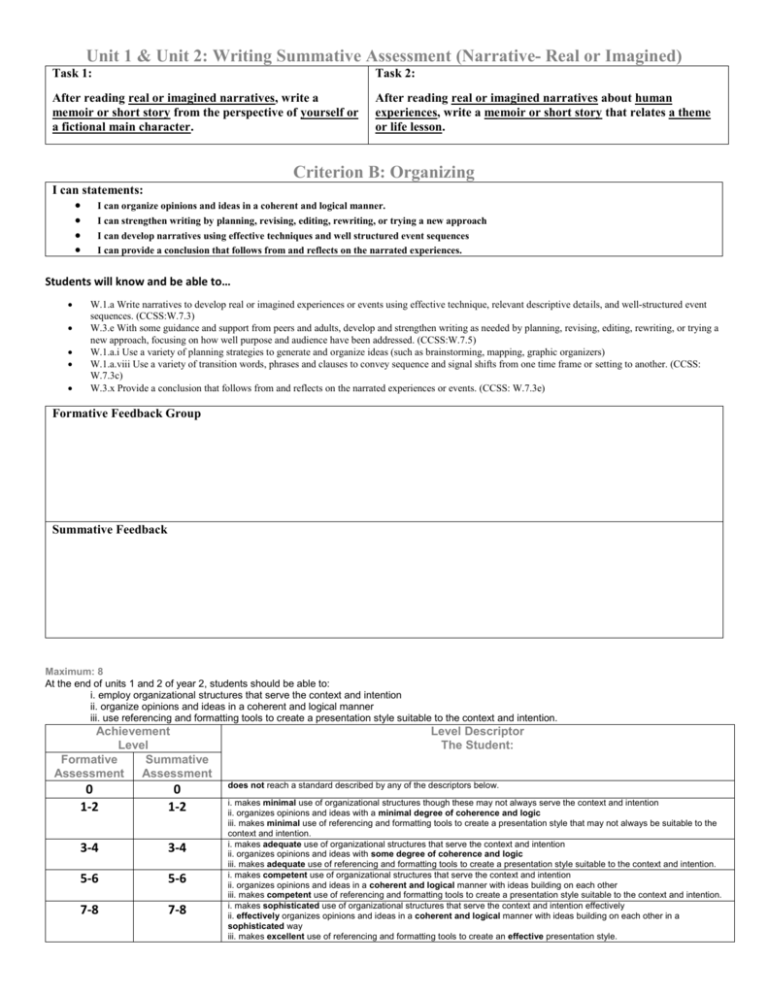
Unit 1 & Unit 2: Writing Summative Assessment (Narrative- Real or Imagined) Task 1: Task 2: After reading real or imagined narratives, write a memoir or short story from the perspective of yourself or a fictional main character. After reading real or imagined narratives about human experiences, write a memoir or short story that relates a theme or life lesson. Criterion B: Organizing I can statements: I can organize opinions and ideas in a coherent and logical manner. I can strengthen writing by planning, revising, editing, rewriting, or trying a new approach I can develop narratives using effective techniques and well structured event sequences I can provide a conclusion that follows from and reflects on the narrated experiences. Students will know and be able to… W.1.a Write narratives to develop real or imagined experiences or events using effective technique, relevant descriptive details, and well-structured event sequences. (CCSS:W.7.3) W.3.e With some guidance and support from peers and adults, develop and strengthen writing as needed by planning, revising, editing, rewriting, or trying a new approach, focusing on how well purpose and audience have been addressed. (CCSS:W.7.5) W.1.a.i Use a variety of planning strategies to generate and organize ideas (such as brainstorming, mapping, graphic organizers) W.1.a.viii Use a variety of transition words, phrases and clauses to convey sequence and signal shifts from one time frame or setting to another. (CCSS: W.7.3c) W.3.x Provide a conclusion that follows from and reflects on the narrated experiences or events. (CCSS: W.7.3e) Formative Feedback Group Summative Feedback Maximum: 8 At the end of units 1 and 2 of year 2, students should be able to: i. employ organizational structures that serve the context and intention ii. organize opinions and ideas in a coherent and logical manner iii. use referencing and formatting tools to create a presentation style suitable to the context and intention. Achievement Level Formative Summative Assessment Assessment 0 1-2 0 1-2 3-4 3-4 5-6 5-6 7-8 7-8 Level Descriptor The Student: does not reach a standard described by any of the descriptors below. i. makes minimal use of organizational structures though these may not always serve the context and intention ii. organizes opinions and ideas with a minimal degree of coherence and logic iii. makes minimal use of referencing and formatting tools to create a presentation style that may not always be suitable to the context and intention. i. makes adequate use of organizational structures that serve the context and intention ii. organizes opinions and ideas with some degree of coherence and logic iii. makes adequate use of referencing and formatting tools to create a presentation style suitable to the context and intention. i. makes competent use of organizational structures that serve the context and intention ii. organizes opinions and ideas in a coherent and logical manner with ideas building on each other iii. makes competent use of referencing and formatting tools to create a presentation style suitable to the context and intention. i. makes sophisticated use of organizational structures that serve the context and intention effectively ii. effectively organizes opinions and ideas in a coherent and logical manner with ideas building on each other in a sophisticated way iii. makes excellent use of referencing and formatting tools to create an effective presentation style. Criterion D: Using Language I can statements: I can communicate my thoughts in writing effectively using the correct conventions (non-negotiables). I can use appropriate and varied vocabulary, sentence structures and forms of expression I can write and speak in an appropriate register and style I can use correct grammar, syntax and punctuation I can spell (alphabetic languages), write (character languages) and pronounce with accuracy I can use appropriate non-verbal communication techniques. Maximum: 8 At the end of year 2, students should be able to: i. use appropriate and varied vocabulary, sentence structures and forms of expression Correct paragraph format (indented correctly, correct spacing, and appropriate length) Complete sentences (beginning capital letter and end punctuation) (free of run-ons and/or fragments) Correctly write and punctuate varied sentence structures (simple, compound, and/or complex sentences) iii. use correct grammar, syntax and punctuation Parts of Speech (nouns, pronouns, verbs, adjectives, adverbs, and prepositions) Punctuation Marks . ? ! : ; … ’ “ ” / , () Correct word order Agreement: Subject/verb and Pronoun/Antecedent Parallel structures and verb tense Use of titles, names of authors, and proper nouns (capital letters and punctuation) Citations (commas, quotation marks, page/line numbers, parentheses, and accuracy in quotations) v. use appropriate non-verbal communication techniques. ii. write and speak in an appropriate register and style Formal vs. informal style (word choice is suitable to the task) Dialogue (punctuation, format, and dialogue tags are used appropriately) No stray capital letters iv. spell (alphabetic languages), write (character languages) and pronounce with accuracy Contractions (apostrophes) Homophones (word choice/spelling) Plurals (adding –s, -es, -en, etc.) Possessives (using apostrophes correctly) Formative Feedback Group Achievement Level Formative Summative Assessment Assessment 0 1-2 0 1-2 3-4 3-4 5-6 5-6 7-8 7-8 Level Descriptor: The student does not reach a standard described by any of the descriptors below. i. uses a limited range of appropriate vocabulary and forms of expression ii. writes and speaks in an inappropriate register and style that do not serve the context and intention iii. uses grammar, syntax and punctuation with limited accuracy; errors often hinder communication iv. spells/writes and pronounces with limited accuracy; errors often hinder communication v. makes limited and/or inappropriate use of non-verbal communication techniques. i. uses an adequate range of appropriate vocabulary, sentence structures and forms of expression ii. sometimes writes and speaks in a register and style that serve the context and intention iii. uses grammar, syntax and punctuation with some degree of accuracy; errors sometimes hinder communication iv. spells/writes and pronounces with some degree of accuracy; errors sometimes hinder communication v. makes some use of appropriate non-verbal communication techniques. i. uses a varied range of appropriate vocabulary, sentence structures and forms of expression competently ii. writes and speaks competently in a register and style that serve the context and intention iii. uses grammar, syntax and punctuation with a considerable degree of accuracy; errors do not hinder effective communication iv. spells/writes and pronounces with a considerable degree of accuracy; errors do not hinder effective communication v. makes sufficient use of appropriate non-verbal communication techniques. i. effectively uses a varied range of appropriate vocabulary, sentence structures and forms of expression ii. writes and speaks in a consistently appropriate register and style that serve the context and intention iii. uses grammar, syntax and punctuation with a high degree of accuracy; errors are minor and communication is effective iv. spells/writes and pronounces with a high degree of accuracy; errors are minor and communication is effective v. makes effective use of appropriate non-verbal communication techniques.
